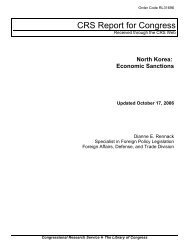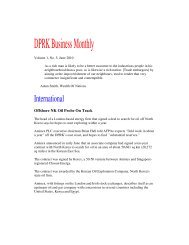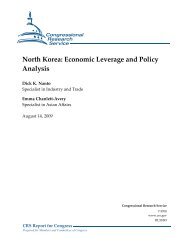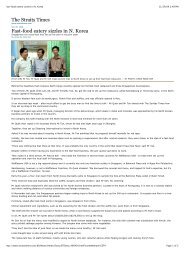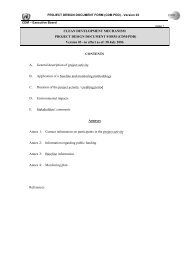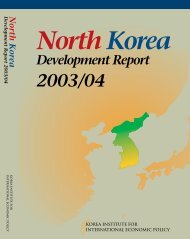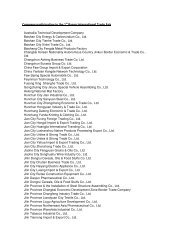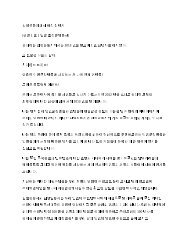North Korean Policy Elites - Defense Technical Information Center
North Korean Policy Elites - Defense Technical Information Center
North Korean Policy Elites - Defense Technical Information Center
Create successful ePaper yourself
Turn your PDF publications into a flip-book with our unique Google optimized e-Paper software.
of associates who trace their relationship to him from different angles. This not only necessitated<br />
a very cautious power building strategy based on letting first generation leaders die off and<br />
elevating second generation leaders to key posts, it also made it vital that Kim Chong-il not tie<br />
his ability to lead strictly to the formal leadership. 13 As such, Kim retains some of Kim Il-song’s<br />
close associates to serve as a bridge to the country’s revolutionary past. Most of the key positions<br />
within the regime, however, are occupied by people of Kim’s generation who hail from the<br />
Three Revolution Movement squads, the classmates of the Mangyongdae Revolutionary Institute,<br />
and the graduates of the Nassan School and the Kim Il-sung University, all key institutions in<br />
Kim Chong-il’s background. The table below illustrates some of the most prominent leaders<br />
within the Kim Chong-il regime and their critical relationships.<br />
Table II-4. Illustrative Relationships in the Kim Chong-il Regime<br />
Name Position Relationship(s)<br />
Kim Kyong-hui Director, KWP Light<br />
Industry Department<br />
Kim Yong-nam President, SPA Brother of Kim Tu-nam,<br />
former military aide –decamp<br />
to Kim Il-sung and<br />
Kim Ki-nam. May be<br />
related to Kim Chong-il<br />
through marriage.<br />
Kim Yong-sun<br />
Former KWP<br />
Secretary for<br />
ROK/Japan Affairs<br />
(deceased)<br />
Close friend of Kim<br />
Kyong-hui<br />
Yon Hyong-muk Member NDC Related to a partisan<br />
compatriot of Kim Il-sung.<br />
Yon also reportedly had a<br />
close relationship with the<br />
late Kim.<br />
Kim Chol-Man Former Member<br />
NDC<br />
Kim Chong-il<br />
Relationship<br />
Kim Chong-il’s sister.<br />
Wife of Chang Songtaek.<br />
In 1960s, helped<br />
purge KWP<br />
International<br />
Department of Pak<br />
Kum-chol/Pak Yongkuk<br />
faction.<br />
Economic adviser to<br />
Kim Chong-il. Worked<br />
in the OGD and Three<br />
Revolution Teams.<br />
Worked with Kim<br />
Chong-il in<br />
establishing Kim Ilsung’s<br />
system of<br />
unitary leadership.<br />
13 The most insightful work being done on Kim Chong-il’s power building strategy is by Jei Guk Jeon, a freelance<br />
scholar in Seoul. Jei argues that Kim has employed a balancing act between political forces. This strategy, which<br />
is characterized by inclusive politics, honor-power sharing arrangements, and divide-and-rule tactics, has turned<br />
out to be an effective way of clearing away potential cleavages built into the ruling circle. See “The Politics of<br />
Mourning Ritual in <strong>North</strong> Korea (1994-1997),” World Affairs (Winter 2000); “<strong>North</strong> <strong>Korean</strong> Leadership: Kim<br />
Jong-il’s Intergenerational Balancing Act,” The Strategic Forum, No. 152 (December 1998).<br />
II-11



